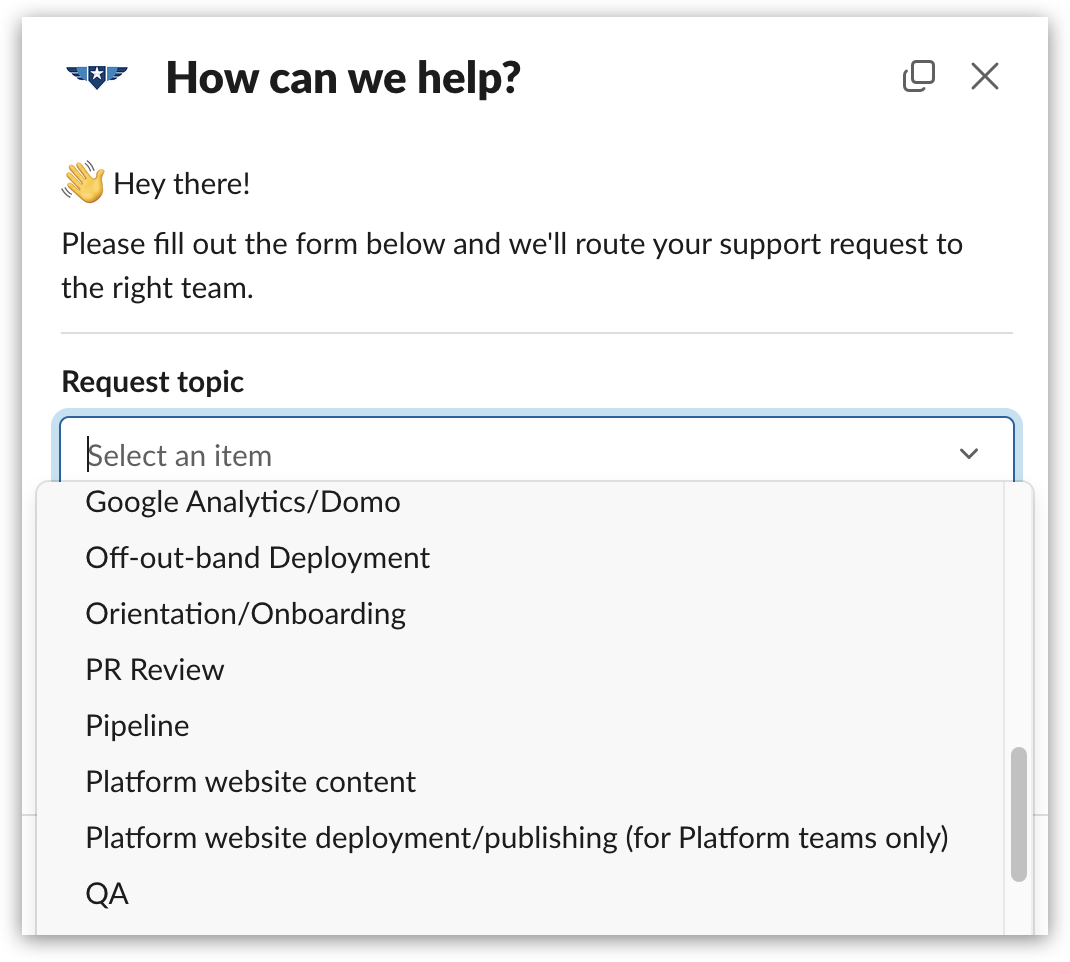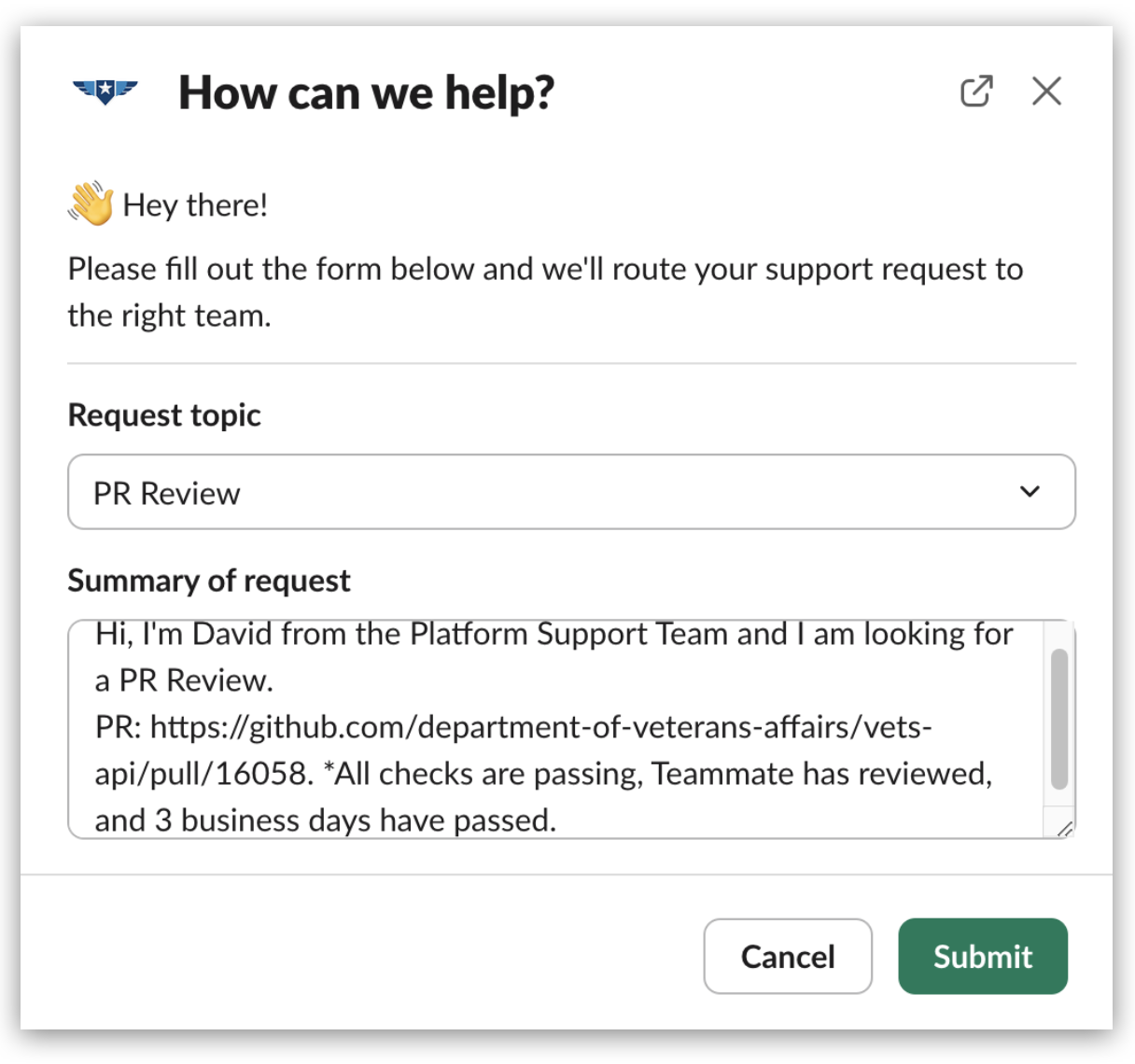Support Best Practices
Last Updated:
This document will amend current support team documentation by reflecting the addition of a “triage” unit to Tier 1 level support.
Tier 1 Overview
When a request comes through the #vfs-Platform-support Slack channel, the Platform Support Tier 1 Team responds by taking ownership of it, referring it to a different channel or triaging it to Tier 2.
https://youtu.be/m5kBulhj3cM
Types of Support Requests
Specific Examples of Requests:
What We Can Help With - Platform Support
There are two types of support ticket types: one-off requests and recurring Platform technical tasks.
One-off Requests
One-off support issues are sent via the Slack Channel using the Support Bot (see https://depo-platform-documentation.scrollhelp.site/support/getting-help-from-the-platform-in-slack for more details on this process).
Support requests can vary by topic but some categories include:
API
Access Request
Accessibility
App Logging/Monitoring
App Setup
Automated Tests
CIError
Collaboration Cycle
Console UI
Content & IA
Datadog
Design
Design System
Environments
Failed Deployment
Forms
Google Analytics/Domo
Off-Cycle Deployment
Orientation/Onboarding
PR Review
Pipeline
Platform website ontent
Platform website deployment/publishing (for Platform teams only)
QA
Review Instance
Security
Something Else
Test Accounts/Data
Test Failure
Testing Support Form
Testing Tool Access
Testing Tools
Recurring Platform Technical Tasks
In addition to one-off support requests, the Platform Support Team is responsible for a group of recurring tasks. These recurring tasks include:
Certificate Renewals (SSL)
SOCKS access
Reviewing PRs
Vets-API session key rotation
Monitoring the health of the infrastructure
Submitting a Ticket
Before Submitting a Ticket
Sending Messages Instead of a Ticket
Please do not submit and issue in the #vfs-Platform-support channel as a message. Often times, it's lost amongst the created tickets. Please, create a ticket following the steps outlined here.
Have you attended Platform Orientation?
Platform Orientation was designed to onboard and orient new VFS teams and VFS team members to Platform products, processes, services, standards and expectations.
All VFS users get added to the vets.gov-write GitHub team during Platform Orientation. If you're not a member of that team, we'll check if you're on the VFS Roster. If your name does not appear, you'll most likely need to go through Platform Orientation.
Update Your Profile in Slack
Having this information at a glance can sometimes speed up a support request.
To ensure the quickest response time, we require additional information to know what type of request we're dealing with and where it's coming from. Please ensure your profile includes the following:
Full Name
Email
Role/Company
You can view the full process here: https://depo-platform-documentation.scrollhelp.site/getting-started/request-access-to-tools#Requestaccesstotools-Slack
Fill Out All Support Bot Fields
Type /support into the message field on the Slack channel #vfs-Platform-support
We have carefully curated our Support Bot questions to ensure they do not become overwhelming, however, those that remain are necessary to getting you the quickest response time. Please make sure to fill out all of the following fields:
Request Topic: Drop-down menu of various topics, select the option that most closely matches the topic of your request.

Summary of request: provide enough information for the Platform team to respond to your request. The preferred format for the request is: Who, What, Why (if applicable).
Who: Please include your Name and Team
What: Provide a clear and concise description of your request. If you are submitting a PR please include the URL and code snippets when necessary.
For Bugs/Issues: please include Steps to Reproduce, Error Messages, Backtrace(if possible), Expected/Current Behavior, Context(repo, environment)
Why: Please explain the impact if the request is urgent.

How to Submit a Ticket
You can view the process for submitting a ticket here: https://depo-platform-documentation.scrollhelp.site/support/getting-help-from-the-platform-in-slack
After a Ticket is Submitted
How Tickets Are Updated
Below are the best practices for how the Platform Support team updates tickets.
When a Ticket Has Been Seen
Once a ticket has been seen, reviewed and is actively being worked on, Support Team will place an 👀 (eyes) emoji on the Slack ticket post. The team will then determine if it's something they can handle or if it needs to be sent to the Tier 2 team.
Tier 2 Overview
When a ticket is escalated to Tier 2, a member from one of the Communities of Practice (CoP) will review the issue. CoPs on Platform Support are DevOps, Front End, and Back End.
When There is an Update to A Support Ticket
Follow up questions and clarifications will be added to the Slack thread as they become available. Status updates will be added to the original GitHub ticket.
When the Ticket is Complete
A ✅ (green checklist) emoji will be marked on the Slack ticket to note it's been closed by support. Typically a reply will also be given noting that the process is complete.
What To Do If An Incident Is Suspected
Incident management - Follow These Steps
Detailed steps at the link above, regarding how to report incidents to the Platform and provide relevant information to aid in routing reported issues to other appropriate teams.
Request Policy and Response Times
Please Read Details on https://depo-platform-documentation.scrollhelp.site/support/support-overview#Supportoverview-Supportrequestpolicies
Note: These are estimates and may differ from reality dependent upon extenuating circumstances.
Issue Severity Level | Issue Severity Label | Expected Time to Confirm Receipt | Expected Time to Resolution | Definition of Severity | Examples of Severity Level |
|---|---|---|---|---|---|
Critical | Platform-sev-s0 | Within 15 minutes | Same Day |
|
|
Additional Resources - Take a look at:
Specific Examples of Requests - What We Do & What We Don’t Do
What We Can Help With - Platform Support
Help and feedback
Get help from the Platform Support Team in Slack.
Submit a feature idea to the Platform.
